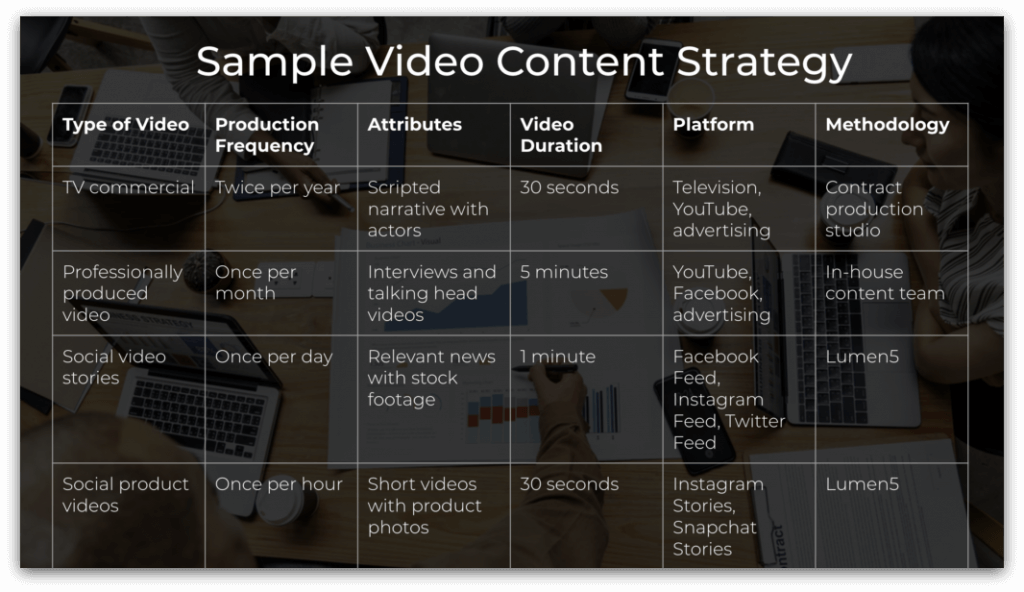
Let’s just start off by saying this – creating a video marketing calendar is the best decision that you can make for your business.
Don’t believe me? Well, for those skeptics out there who almost defiantly stick to traditional methods of planning and organization, I’ve got news for you – time to upgrade.
We all know that video is one of the best digital mediums to engage any audience — it’s entertaining, practical, and can maintain viewer interest longer than other forms of content.
In a study published in the Journal of Strategic Marketing, findings indicated that producing high-quality video content had become a major marketing strategy for businesses looking to be successful in the modern market.
You see, customers today are spoiled for choice. They often spend quite a lot of time researching before making a purchase, especially when it’s a first-time purchase. This means that brands that take the time to produce premium, relevant content are the most likely to be rewarded over time.
The best way to produce high quality and relevant content, even for videos, is to be consistent and organized. That requires a content calendar.
This post will go over how to create a video marketing calendar to meet your video marketing goals.
What is a Video Marketing Calendar?
In order to define what a video marketing calendar is, we first need to explain what a content calendar is.
For those who may not know, a content calendar or editorial calendar is essentially a resource that teams use to plan all their content activity whether that’s creating a book marketing plan or even marketing a course.
It allows them to arrange how their content will be distributed over the next few months or even years. It is typically organized in a calendar-based format as opposed to a list of content to be published.
Bearing that in mind, a video marketing calendar is simply a representation of your content calendar in video format. This concept was born from the need to adapt to how today’s consumers, including the members of your very own team, interact with content.
Why You Should Create a Video Marketing Calendar
Many who have incorporated a video marketing calendar in their organizational processes are already seeing the benefits that it brings. Video marketing calendars enable you to do so many things, like:
- Planning ahead: For any project to be successful, proper planning is required. So why not use a video to help you develop your plans ahead of time?
This is what a video marketing calendar does. As you know, it will take the form of a marketing calendar which displays your content’s trajectory in a video format.
This means that you can quickly see which videos need to be created ahead of time, thus giving you and your team plenty of time to do them.
- Previewing your video content: Most times, even though we’ve mapped out the course of a project, doubts linger in our mind.
How’s it going to turn out? Is it going to look like what we wanted? Did we miss anything?
We get it – just like you, we like to dot our I’s and cross our T’s. Thankfully, a video marketing calendar makes life a whole lot easier for us perfectionists.
They create a clear vision of how your video content will be distributed based on whatever time span you’ve given for the project.
Depending on how detailed your video marketing calendar is, it can have the added benefit of giving you a small preview into how your content will look. With that, you can spot areas that may need to be worked on before you go live with your content.
Nifty, right?
- Facilitating Better Internal Communication: Whenever you’re working in a team, good communication is crucial to the success of just about every project. All parties involved should clearly understand the project in its totality – if not, problems can arise.
Sharing your content calendar in video format does just that – it details the scope of the project in a fun and engaging way for all team members to see.
As we know, it’s important to use tools that even our team will be inclined to use. That way, you increase productivity.
The same goes for video formatting. Everyone in your company will be on the same page as they will know what is being published, when and where. It also ensures that there is no duplication of content.
Besides, it streamlines the video creation process to make your project run smoother.
- Identifying key content milestones: As a content producer, you understand the importance of releasing well-timed content. Your goal is to produce content which is well received by a wide audience.
For this reason, many content makers issue content when it would most likely bring returns on their efforts – like around a major social event. I mean, it’s obvious – releasing a video review of the latest Apple device shortly after it’s been released would likely bring your site more traffic than if you were to release it at any other time, right?
That being so, a video marketing calendar helps you to structure when you’ll be releasing content. With it, you can plan your content around specific events and important dates, organically maximizing potential rewards on your marketing efforts.
- Adding Consistency To Your Marketing Goals: To be successful at content marketing, you need to be consistent. There’s no way around that. You need to come up with a plan and stick to it.
Granted, you may need to make changes along the way, but sticking to a content strategy blueprint will bring you closer to your goals. This is where video marketing calendars come into play – they give you structure and order to your goals and help make them a reality.
Video Marketing Calendar – Getting Started
Every successful venture is accomplished by following carefully planned steps – designing a video marketing calendar is no exception. Following these steps detailed below will set you on the right path to developing a content strategy that works for you and your goals.
#1 – Pick a Calendar Tool
Every content creator knows that using content creation tools can go a very long way in bettering your final product. The same principle goes for creating a video marketing calendar – implementing a calendar tool is a great resource that will help you organize your content.
Simply put, a calendar tool can be as simple as a big sheet of paper with months and dates marked out. The simpler the tool, the better.
If you work with a team, then an online calendar would be best. We recommend starting off with Google Calendar (it’s free and easy to use).
# 2 – Think Big, Then Narrow It Down
The easiest way to create a video marketing calendar is to look at your entire calendar — the year as a whole — and mark down any big occasions or events you want to create content for. In doing so, you can accurately estimate how much time you need to prepare in advance.
You may already have an idea of the peak times to market products in your industry. If you are unsure, conduct research into your competitors and identify seasons in which they boost their marketing efforts. This will give you an idea of the most successful time for returns on investment.
For example, some food companies market more heavily during winter or summer depending on which times of the year customers would be drawn to that food product. An ice cream company would focus heavily on advertising during warmer months, taking advantage of the change in temperature to tempt their customers.
So, identify peak seasons for your industry and plan your video content accordingly.
Next, you need to highlight your vacation times, days off, and other non-working days in order to give you a realistic view of your planning and execution timeframes.
#3 – Allocate a Calendar Manager
If you have a particularly busy schedule, it’s best to allocate someone to oversee your content calendar. This would mean that you would have one point of contact who will add information to the calendar or amend it accordingly, and also follow up on timelines for upcoming events.
Make sure that the person that you choose has the characteristics to do this successfully. You should look for someone who is organized, diligent, and great at using the technology that works with your calendar.
#4 – Determine Frequency Of Developing Video Content
The next step is to figure out how often you want to create video content. It could be daily, weekly, monthly – that would depend entirely on your respective marketing goals.
Mark down the frequency on your calendar.
This step is important as it makes you aware of how many mini-projects potentially require planning and organization within your broad marketing plans.
#5 – Choose The Type of Videos
Next is to figure out the types of videos you want to create.
In deciding which types of videos to create, you need to think about how much time and coordination would be required to perfectly produce the video. For example, who will be in it? How much time will you need to shoot it? (Note: you can create professional videos in Lumen5 in under 5 minutes!)
Refer to the more detailed video content strategy image below!

If you’re just starting out, you could start off with “how to” videos, client testimonials, and behind-the-scenes, among other things.
#6 – Develop Your Video Content
The final step in this process is really the meat of the entire project – generating content for the video.
Before you say that you don’t have anything that can work as content, think again. Believe it or not, you already have enough sales material that can be converted into great video content. Just take a look at all the information you have collated about your brand and then think creatively about how you can showcase or develop it.
This process will enable you to clearly see what you have already created, and give you some ideas on where to go from there.
We recommend you use Google Sheets (it’s free!) during this process. The great thing about it is that you can use multiple tabs on the spreadsheet to jot plans for production of content.
Plus, it can be easily edited and accessed by your team. Once you start publishing content, you can continue to keep them under your tabs for easy reference, and even add URL links.
That said, in as much as developing a video marketing calendar is important, it doesn’t guarantee that your marketing efforts will be successful. You still have to make compelling and engaging videos. So, don’t neglect the concepts that you need to implement in order to bring you video marketing success.
Video Marketing Calendar – Know Your Limits
This is the best piece of advice anyone ever gave me when it came to developing marketing goals. Before you start setting them out, know your budget. Might seem like a no-brainer, but often, people rush into developing all types of strategies without thinking about their financial limits.
Setting your budget will help you greatly. Apart from allowing you to highlight financially feasible initiatives, they also keep you and your finances in check.
Your budget will determine how often you create and publish videos: unless, of course, you’re using Lumen5. Your budget will also help you easily determine what times of the year are worth investing in more heavily.
All in all, it’s simply smart to align your plans and resources.
Wrapping Up
Remember that content is always changing and so is technology. A video marketing calendar is designed to be flexible to meet your needs. However, you need to ensure that you’re always keeping an eye on your performance and update your deliverables on video production workflow.
I’m doing so, you will become more organized and consequently maintain a consistent video marketing schedule that drives results.
For now, say goodbye to disorganization and hello to video marketing calendars!






